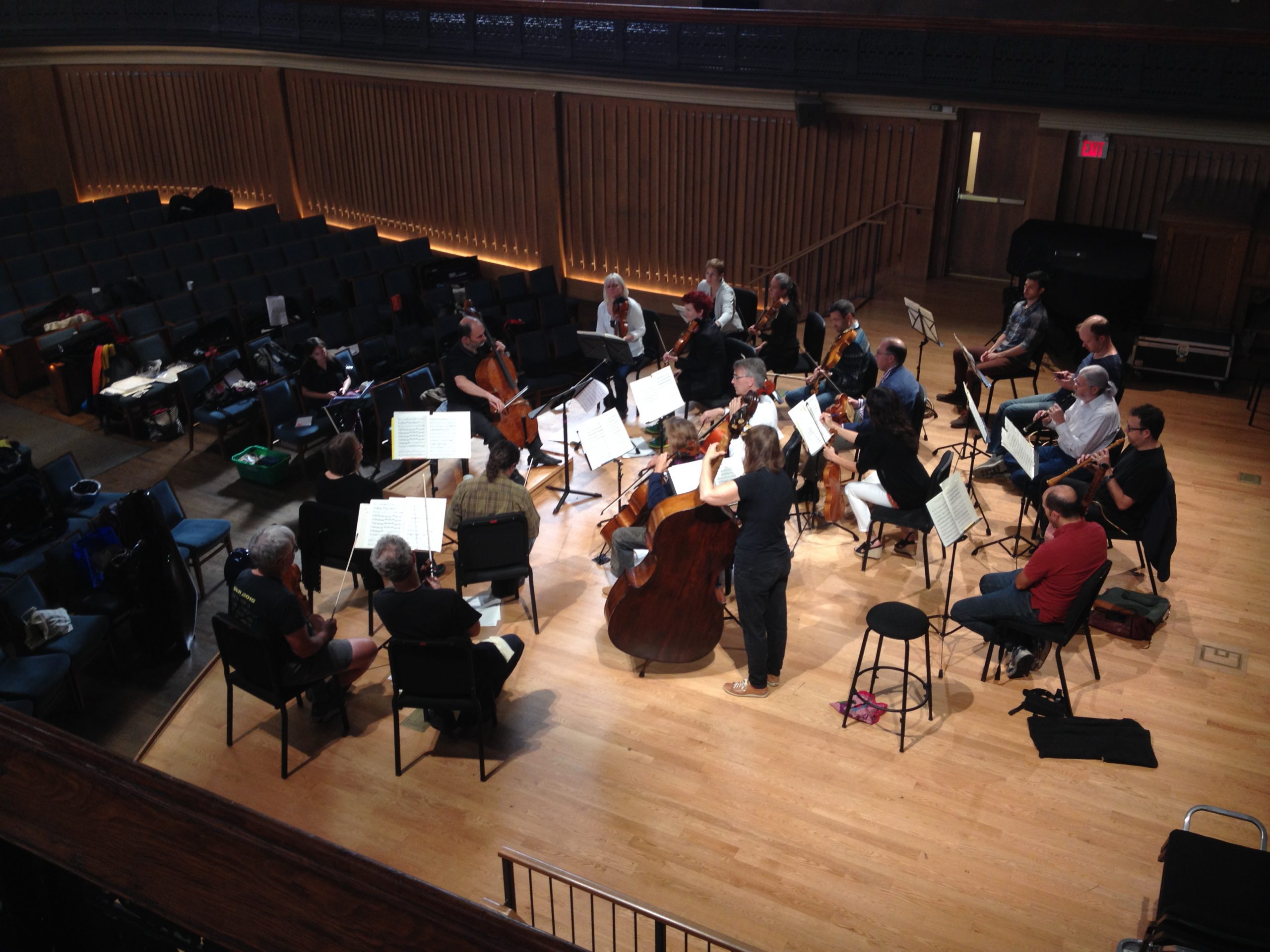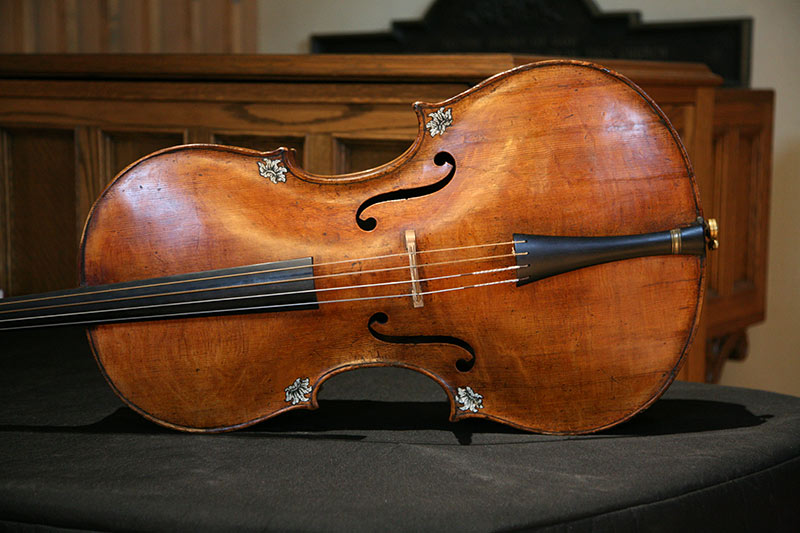By Andrew Eusebio, Marketing and Development Associate
French cellist and guest director, Christophe Coin, makes his Tafelmusik debut with The Eloquent Cello. He took some time between rehearsals to chat with our Marketing Associate, Andrew Eusebio.
After studies with Nikolaus Harnoncourt in Vienna and Jordi Savall in Basel, Christophe Coin quickly established a solo career, and in 1987 formed le Quatuor Mosaïques, a renowned period-instrument quartet whose impressive discography includes works by Haydn, Mozart, Arriaga, Boccherini, Jadin, Beethoven, Schubert, and Mendelssohn. He teaches baroque cello and viola da gamba at his alma maters, the Conservatoire de Paris, and the Schola Cantorum in Basel.
 Christophe Coin leads the orchestra in rehearsals
Christophe Coin leads the orchestra in rehearsals
Andrew Eusebio: In your opinion, what is it about the cello that audiences love?
Christophe Coin: I think the cello is maybe one of the most appreciated instruments probably because it is so similar to the human voice. It’s very lyrical and very expressive of all sorts of emotions. Sometimes the violin is a more virtuosic instrument, but it has a rather limited range at the bottom end, and people like to be moved by lower voices.
This fashion is quite new, I think. When I started cello, for example, the cello class in my hometown, in Caen, had few pupils. My teacher there was a fantastic cellist, a fantastic pedagogue, and a student of Pablo Casals. My mother didn’t want me to learn violin—she didn’t like violin—so we went to this man because there was room in the class, and I have never regretted it.
AE: Some of the pieces in the program have a rich history with Tafelmusik, while others have never been performed on our stage. How was the program selected, and what was your process in pairing them together?
CC: I made three propositions to Jeanne [Lamon]. My first proposition was to perform Haydn’s D-Major cello concerto and a concerto by Antonin Kraft, who was the principle cellist in Prince Nikolaus’s orchestra at Esterházy. I believe Hadyn’s D-Major was probably composed for Kraft. This is similar to Sergei Prokofiev or Dmitri Shostakovich composing a piece for cellist Mstislav Rostropovich: a composer working with an idiomatic specialist of the instrument. But, the Kraft concerto would have needed more wind instruments, and we wanted to limit the concert to two oboes and two horns. So I think Jeanne was very happy to do the Boccherini concerto. I suggested this one because I have never played it, so it’s a new opportunity for me—and it’s the only one with an original cadenza by Boccherini in the slow movement. It’s at least one cadenza I don’t have to write or think about!
AE: What is it like to direct an orchestra while playing the cello part, as you’re doing in the Dittersdorf and CPE Bach?
CC: Well, I did it a long time ago when we started a group in Paris called Mosaïques, which had a mixture of different people from different orchestras—people who wanted to learn this repertoire. This was almost 40 years ago, at that time, many people didn’t play Haydn symphonies. This orchestra disappeared and the principal people remained together as a quartet, Quatuor Mosaïques, which is still active after 30 years.
When we started as an orchestra, I was leading from the cello: we never had a conductor. So I’m used to that and I like it. I don’t like to move my arms much if I can avoid it. Sometimes it’s a problem with a group that’s not well connected, but with Tafelmusik, they know each other so well and they are used to playing without a conductor, so I think it’s not a problem. But, in fact, the cello is playing a bass line, a normal bass line.
 Christophe Coin’s 1720’s Italian cello with bone details
Christophe Coin’s 1720’s Italian cello with bone details
AE: The Haydn cello concerto has a special connection to many people. What is your personal connection to this masterful piece and why?
CC: You know this piece has been rediscovered quite recently. Well, recently being the 1960s. Before, only the D-Major, which is a much larger concerto, was played. And since the C-Major appeared, the D-Major is not so often played, which is a pity. It’s another level of difficulty—and, the Finale, which is a sort of French tune, something 6/8, is less flashy than the finale of the C-Major. It’s sort of a “wet blanket” Finale. So, people nowadays play the C-Major more.
My special connection I would say is that I recorded it, actually before Anner Bylsma recorded it with Tafelmusik, and it was my first recording as a soloist, and my first recording on a historical instrument. That was with Christopher Hogwood and the Academy of Ancient Music. I was 23, and I had a cello made especially for that recording. That was my first experience playing and recording a concerto, so it’s quite important for me, this recording.
AE: That is a special connection. When was the last time you performed it?
CC: Maybe two to three years ago.
AE: Not so long ago, but I’m sure it’s great to play it again.
CC: Yes, it’s nice to play it again, especially with such a good orchestra!
AE: What do you believe to be the next great frontier for period ensembles in terms of repertoire?
CC: I don’t know. Nowadays, some orchestras on period instruments play Debussy and Ravel. With the quartet (Quatuor Mosaïques), we play Bartok’s first and second quartet on gut strings. I think that’s the limit. I mean, until the first World War, gut strings were used, quite generally, in all orchestras, and then it progressively changed. Between the two wars, I think people started to change strings—the violin for the E string because they broke most easily. Maybe the cellists were the last to change. Nowadays, it would be impossible to go to a modern orchestra with gut strings. I think there is no reason not to play twentieth-century repertoire on gut strings.
It’s a little more complicated for the winds, such as the oboe or clarinet, because the keyed instruments changed a lot during the nineteenth century and the evolution was complicated. It’s difficult to have twenty different instruments to play the repertoire that spans the nineteenth century. I have heard some Wagner and Mahler with period instruments already. I’m not sure it really brings something completely new. The most important thing for me is the concept you have behind a performance, not so much the instruments themselves.
Maybe it’s also interesting to have modern composers write pieces for period instruments. I know that Tafelmusik has commissioned new pieces. Of course, it’s not so interesting when a composer uses period instruments as a gimmick. But if you really try to understand the technique and the possibility of generating a new sound, I think it’s a challenge for the composer.
Join us for The Eloquent Cello, October 5-9 at Jeanne Lamon Hall, Trinity-St. Paul’s Centre. Tickets are available here.
